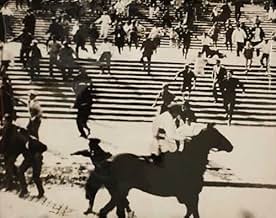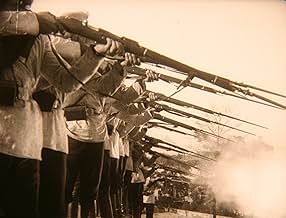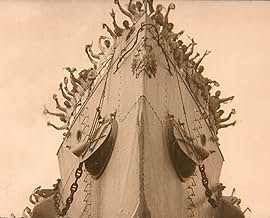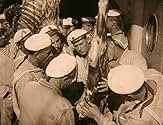IMDb RATING
7.9/10
63K
YOUR RATING
In the midst of the Russian Revolution of 1905, the crew of the battleship Potemkin mutiny against the brutal, tyrannical regime of the vessel's officers. The resulting street demonstration ... Read allIn the midst of the Russian Revolution of 1905, the crew of the battleship Potemkin mutiny against the brutal, tyrannical regime of the vessel's officers. The resulting street demonstration in Odessa brings on a police massacre.In the midst of the Russian Revolution of 1905, the crew of the battleship Potemkin mutiny against the brutal, tyrannical regime of the vessel's officers. The resulting street demonstration in Odessa brings on a police massacre.
- Awards
- 1 win total
Ivan Bobrov
- Young Sailor Flogged While Sleeping
- (as I. Bobrov)
Nina Poltavtseva
- Woman With Pince-nez
- (as N. Poltavtseva)
Iona Biy-Brodskiy
- Student
- (as Brodsky)
Sergei Eisenstein
- Odessa Citizen
- (as Sergei M. Eisenstein)
Andrey Fayt
- Recruit
- (as A. Fait)
Storyline
Did you know
- TriviaThe film censorship boards of several countries felt this movie would spread communism. France imposed a ban after a brief run in 1925; it lifted it in 1953 after the death of Russian leader Joseph Stalin. The UK banned it until 1954.
- GoofsIn the Imperial squadron near the end of the film, there are close-ups of triple gun turrets of Gangut-class dreadnought. It possibly was made this way to show the power of Imperial fleet, but battleships of 1905 were much smaller pre-dreadnoughts, with twin turrets only, just like "Potemkin". "Ganguts" entered service in 1914.
- Alternate versionsSergei Eisenstein's premiere version opened with an unattributed quote from Leon Trotsky's "1905": The spirit of mutiny swept the land. A tremendous, mysterious process was taking place in countless hearts: the individual personality became dissolved in the mass, and the mass itself became dissolved in the revolutionary impetus. This quote was removed by Soviet censors in 1934, and replaced by a quotation from V.I. Lenin's "Revolutionary Days": Revolution is war. Of all the wars known in history, it is the only lawful, rightful, just and truly great war...In Russia this war has been declared and won. The original text was restored in 2004.
- ConnectionsEdited into Seeds of Freedom (1943)
Featured review
I don't recommend that you see this as a 'landmark' in film; don't merely pass through to say you did, or because it's a travelled destination for most people. Instead, come to this with fresh eyes if you can. Rarely since has a film - and film tradition - been so deeply centered within its worldview, rarely indeed is a film made of the very fabric of the world it gives voice to. Most films these days are built at random, or from random spare parts.
Eisenstein had already made a more successful film before this, more reflexively about the seeing eye. So, even though there is a more rip-roaring story here, you may have to struggle a bit with how faceless appears this world to us, these days so accustomed to the paradigm of the individual hero. But Eisenstein was an architect - literally, as well as in film - and so space matters, our relationship with space through motion matters.
In other words; this may have been preserved to us as a museum piece, which is an indictment of our own understanding of cinema as coming down to us by the books and lists of assorted institutions, but at the time it was part of the most deeply revolutionary film school, one that rigged trains as movie studios and sent them scurrying the countryside to film the people and show them to themselves. I mean, here was a man - Eisenstein - who studied Japanese ideograms to understand synthesized image; who discovered that editing to the beats of the human heart affected more, true or false it shows the desire to both know and reach out.
Our cinematic ideas have mostly regressed into mechanical reproduction since the time when these things were first engineered. Oh, there's plenty of Eisenstein every time you open the TV, but none of it is knowing. It's merely a matter of going-through-the-motions, without the blueprint anymore.
So, look at how crowds are orchestrally conducted through stark geometries, how Eisenstein dissects cinematic space with even a stationary camera. But this type of cinema meant to agitate the people, was never about a thought, it was about an action.
And so with this one. There is the one hero who, although dead, calls out to the people. They rush to him, like ships around their harbor. So on board the ship there is valiant effort for brotherhood and justice, inspired revolution; portside is the motherland, cheering the effort with aplomb. And in the end there is the hero ship, itself filled with heroes, now passing through a sea corridor lined with brother ships, all cheering the one. You can imagine the people cheering at the cinema, who had been there to cheer the real thing years ago.
And when I say 'the real thing' I mean the revolution 8 years before; the Potemkin event depicted here was purely fictional. Yet by the famous steps at Odessa is erected a monument to the fictional sailors, what better example of cinema shaping reality?
So yes, it is a revolutionary film. We may be inclined to make fun of the notions, or worse yet dismiss off-hand because of hindsight knowledge. But this was a film celebrating a time when the world seemed like it could be new again. Then came Stalin and, ironically, vanished all these filmmakers that sung the paeans.
Eisenstein had already made a more successful film before this, more reflexively about the seeing eye. So, even though there is a more rip-roaring story here, you may have to struggle a bit with how faceless appears this world to us, these days so accustomed to the paradigm of the individual hero. But Eisenstein was an architect - literally, as well as in film - and so space matters, our relationship with space through motion matters.
In other words; this may have been preserved to us as a museum piece, which is an indictment of our own understanding of cinema as coming down to us by the books and lists of assorted institutions, but at the time it was part of the most deeply revolutionary film school, one that rigged trains as movie studios and sent them scurrying the countryside to film the people and show them to themselves. I mean, here was a man - Eisenstein - who studied Japanese ideograms to understand synthesized image; who discovered that editing to the beats of the human heart affected more, true or false it shows the desire to both know and reach out.
Our cinematic ideas have mostly regressed into mechanical reproduction since the time when these things were first engineered. Oh, there's plenty of Eisenstein every time you open the TV, but none of it is knowing. It's merely a matter of going-through-the-motions, without the blueprint anymore.
So, look at how crowds are orchestrally conducted through stark geometries, how Eisenstein dissects cinematic space with even a stationary camera. But this type of cinema meant to agitate the people, was never about a thought, it was about an action.
And so with this one. There is the one hero who, although dead, calls out to the people. They rush to him, like ships around their harbor. So on board the ship there is valiant effort for brotherhood and justice, inspired revolution; portside is the motherland, cheering the effort with aplomb. And in the end there is the hero ship, itself filled with heroes, now passing through a sea corridor lined with brother ships, all cheering the one. You can imagine the people cheering at the cinema, who had been there to cheer the real thing years ago.
And when I say 'the real thing' I mean the revolution 8 years before; the Potemkin event depicted here was purely fictional. Yet by the famous steps at Odessa is erected a monument to the fictional sailors, what better example of cinema shaping reality?
So yes, it is a revolutionary film. We may be inclined to make fun of the notions, or worse yet dismiss off-hand because of hindsight knowledge. But this was a film celebrating a time when the world seemed like it could be new again. Then came Stalin and, ironically, vanished all these filmmakers that sung the paeans.
- chaos-rampant
- Aug 21, 2011
- Permalink
- How long is Battleship Potemkin?Powered by Alexa
Details
- Release date
- Country of origin
- Languages
- Also known as
- Potemkin
- Filming locations
- Sevastopol, Crimea, Ukraine(battleship scenes)
- Production company
- See more company credits at IMDbPro
Box office
- Gross US & Canada
- $51,198
- Opening weekend US & Canada
- $5,641
- Jan 16, 2011
- Gross worldwide
- $61,389
- Runtime1 hour 6 minutes
- Color
- Sound mix
- Aspect ratio
- 1.25 : 1
Contribute to this page
Suggest an edit or add missing content































